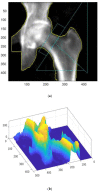New Horizons for Hydroxyapatite Supported by DXA Assessment-A Preliminary Study
- PMID: 35160888
- PMCID: PMC8839981
- DOI: 10.3390/ma15030942
New Horizons for Hydroxyapatite Supported by DXA Assessment-A Preliminary Study
Abstract
Dual Energy X-ray Absorptiometry (DXA) is a tool that allows the assessment of bone density. It was first presented by Cameron and Sorenson in 1963 and was approved by the Food and Drug Administration. Misplacing the femoral neck box, placing a trochanteric line below the midland and improper placement of boundary lines are the most common errors made during a DXA diagnostic test made by auto analysis. Hydroxyapatite is the most important inorganic component of teeth and bone tissue. It is estimated to constitute up to 70% of human bone weight and up to 50% of its volume. Calcium phosphate comes in many forms; however, studies have shown that only tricalcium phosphate and hydroxyapatite have the characteristics that allow their use as bone-substituted materials. The purpose of this study is aimed at analyzing the results of hip densitometry and hydorxyapatite distribution in order to better assess the structure and mineral density of the femoral neck. However, a detailed analysis of the individual density curves shows some qualitative differences that may be important in assessing bone strength in the area under study. To draw more specific conclusions on the therapy applied for individual patients, we need to determine the correct orientation of the bone from the resulting density and document the trends in the density distribution change. The average results presented with the DXA method are insufficient.
Keywords: DXA; density; hydroxyapatite.
Conflict of interest statement
The authors declare no conflict of interest.
Figures






Similar articles
-
Utilization of DXA Bone Mineral Densitometry in Ontario: An Evidence-Based Analysis.Ont Health Technol Assess Ser. 2006;6(20):1-180. Epub 2006 Nov 1. Ont Health Technol Assess Ser. 2006. PMID: 23074491 Free PMC article.
-
Assessment of the strength of proximal femur in vitro: relationship to femoral bone mineral density and femoral geometry.Bone. 1997 Mar;20(3):213-8. doi: 10.1016/s8756-3282(96)00383-3. Bone. 1997. PMID: 9071471
-
Common errors in dual-energy X-ray absorptiometry scans in imaging centers in Ecuador.Arch Osteoporos. 2020 Jan 2;15(1):6. doi: 10.1007/s11657-019-0673-3. Arch Osteoporos. 2020. PMID: 31897808
-
Bone densitometry in Thalassemia major: a closer look at pitfalls and operator-related errors in a 10-year follow-up population.Radiol Med. 2024 Mar;129(3):488-496. doi: 10.1007/s11547-024-01759-1. Epub 2024 Feb 14. Radiol Med. 2024. PMID: 38353863 Review.
-
Osteosarcopenia-The Role of Dual-Energy X-ray Absorptiometry (DXA) in Diagnostics.J Clin Med. 2022 Apr 30;11(9):2522. doi: 10.3390/jcm11092522. J Clin Med. 2022. PMID: 35566648 Free PMC article. Review.
References
-
- National Osteoporosis Foundation . Clinician’s Guide to Prevention and Treatment of Osteoporosis. National Osteoporosis Foundation; Washington, DC, USA: 2010. - PubMed
-
- Watts N.B., Bilezikian J.P., Camacho P.M., Greenspan S.L., Harris S.T., Hodgson S.F., Kleerekoper M., Luckey M.M., McClung M.R., Pollack R.P., et al. American Association of Clinical Endocrinologists medical guidelines for clinical practice for the diagnosis and treatment of postmenopausal osteoporosis. Endocr. Prac. 2010;16:1–37. doi: 10.4158/EP.16.S3.1. - DOI - PMC - PubMed
LinkOut - more resources
Full Text Sources

